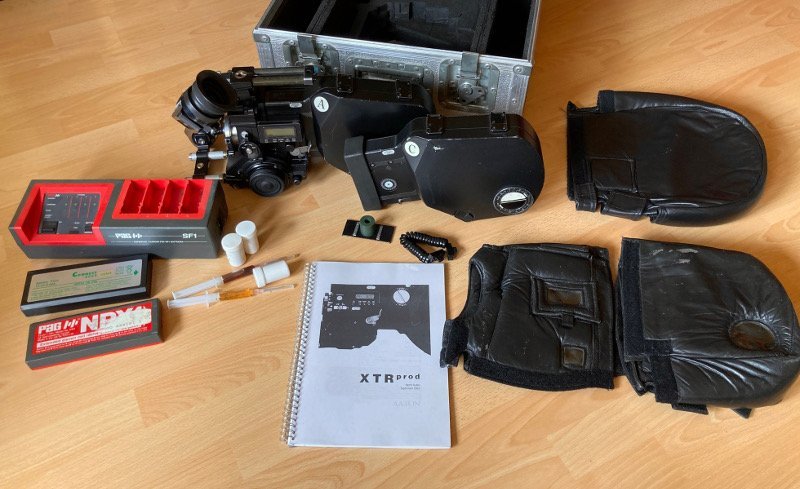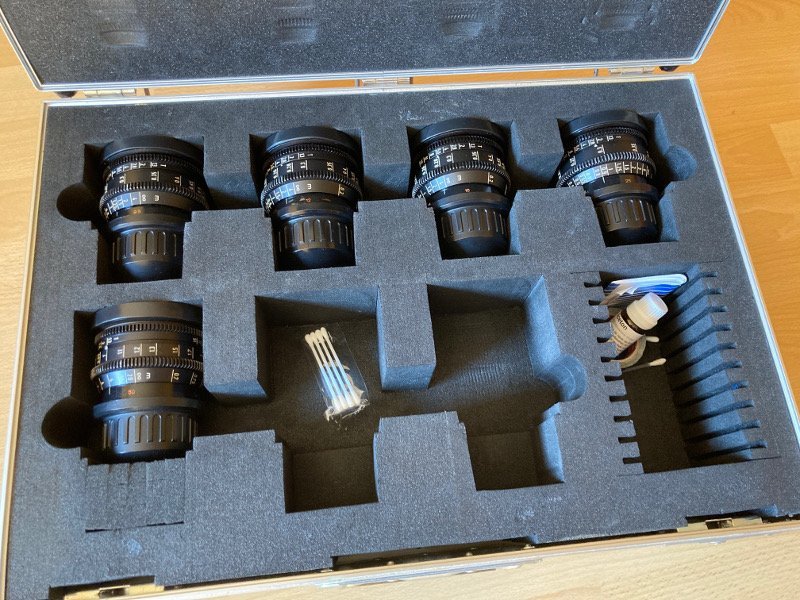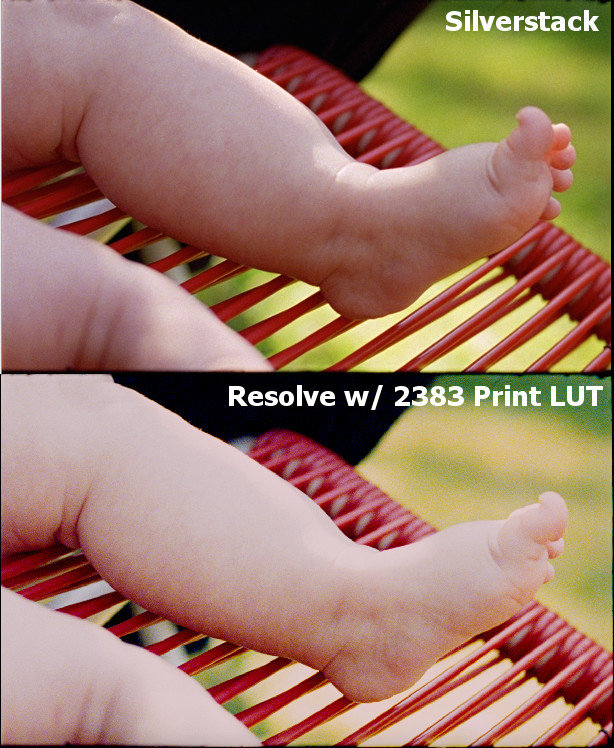
Marc Roessler
Basic Member-
Posts
273 -
Joined
-
Last visited
Everything posted by Marc Roessler
-
Sorry, already sold.
-
FS: S16 Zeiss Superspeed Mk2 Set of 5
Marc Roessler replied to Marc Roessler's topic in Cine Marketplace
9,5 mm 12 mm 16 mm 25 mm 50 mm So, the usual S16 set, as it seems -
Available again, for now.
-
Reserved.
-
Chrosziel Follow Focus for 15mm rods. Dual sided, with extra set of white marking discs. Comes with extension lever, metal transport case, two sets of lens gears. Works fine, minimal play, less than 1mm at the outer end of the extension lever (at end of black ball) when holding the lens gears fixed. More images on request. 650 Eur
-
Selling because I'm giving up my film making hobby: Aaton XTR Prod, S16 camera, with PL-Mount, b/w video assist, lit ground glass (frame lines, with adjustable brightness), two 400 ft mags with loop protectors, two batteries with charger, user manual, special allen key for shutter angle adjustment, original wooden Aaton hand grip including connector cable, heated eye piece including connector cable, flight case, two screw in matte box front rods. Can be synced to time code (tested, works) and can expose Aaton-Code to the film. Built in exposure meter that displays exposure in the viewfinder, I've used this quite successfully. Digital battery and mag remaining readout, digitally settable FPS speed, connector for intervalometer hookup. Shutter 180, 172.8, 150, 144 degrees, camera can run 3 to 73 fps, or single frame exposure when controlled with an external intervalometer (not included). I'm also including a set of origial Aaton grease that I ordered some years ago from Aaton, for servicing the camera. Set also includes two leather barneys for 400 and 800 ft magazines. Attached to the camera (removable) there's a NP1 battery adapter, for using the cheap and uniquitous Sony batteries. The NP1 Batteries included with the set are weak but still good for exposing a few meters of film as a test, I'm inlcuding them as an add on, but you will need to get new ones for film projects. I've used this camera for my short film projects, which have been successfully screened at multiple iternational short film festivals (can send links to the films on request). Really a nice camera - relucant to sell it, but it's only sitting around here, as focus of my life has shifted to other things. Issues noteworthy: the two front rods are slightly angled to one side (but still parallel to each other). It's been like this when I bought it myself, with the short rods it all still aligns nicely with the lens, but I guess with longer lenses (large zooms), longer screw in rods would run away from the lens center at some point. Suggest to use a bottom mounted rod adapter for this case, or a clamp on matte box (as I did). No shipping, only local pickup in northern Bavaria/southern Germany. You can of course test the camera here and expose some test films, if you like. 17.000 EUR More images on request.
-
Set of five S16 Zeiss Superspeeds, Mk2, immaculate condition: no scratches, no spots etc. Including metal case. Selling because I am giving up my film making hobby. 14.500 Eur No shipping, only local pickup in northern Bavaria/southern Germany. More images available on request.
-
With PL-Mount and Chrosziel Fluid-Zoom drive. With clamp on matte box (for 4x4 filters). Lens is in very good shape, this was my favorite lens to use. Selling because I am giving up my film making hobby. Fluid Zoom drive holder (clamp) is broken and therefore loose, needs to be replaced, removed or fixed for proper operation. More images available on request. Personal pick up very much preferred (northern Bavaria/southern Germany). Will also ship, but pick up is very much encouraged for safe payment and reducing risk oif damage during shipping. 4400 EUR
-
Hi guys, while browsing through the catalogs of European (German, to be precise) light equipment suppliers I noticed that professional 230V halogen lamps are increasingly hard to find... it almost seems like 240V lamps are the new standard? Does anyone know why? Mains voltage (single phase/phase to neutral) in Europe is still 230V +/-10%, so why are vendors increasingly introducing 240V bulbs? (Or is the manufacturers?) 240V lamps in a 230V (+/-23V) grid are very inconvenient... It's easy to dim down a 230V lamp if voltage is too high. Boosting voltage to 240V is not so simple in comparison... Even assuming mains may be (if we're lucky) at 240V (well within the tolerance range): when pulling a few amps (as is typical at a film set), voltage typically will go down quite a bit due to line losses, moving away from 240 Volts (and making the lamps warmer)... Am I missing anything here? Cheers, Marc
-
Polyester (aka Estar) base also is problematic with regard to light piping. Not so much of a problem for print film in the lab, but it is a somewhat of a problem for 100' daylight rolls and even when loading 16mm two-chamber mags like Arri or Aaton. The light bounces around within the base and is carried far into the roll, much further than with triacetate stock.
-
Simon, are you sure about the 1.33 for 35mm? (Or was this only with regard to 16mm formats? I wasn't quite sure from what you wrote.) Torkell Saetervadet's (excellent) book "The Advanced Projection Manual" (I have the 2006 release) says that after 1.33 silent and 1.19 movietone the aperture was brought to 1.37 by AMPAS. The reason given was that theaters got bigger, with that the down-angle tilt increased, and thus also the sideways cropping due to keystoning increased. To wind up with (on average) 1.33 again on the screen, the actual aperture was defined as 1.37. So if one wants to see it without any cropping, one would use a 1.37 aperture? All the best, Marc
-
My experience is, when you're in the changing bag (or a dark room) you need all the tactility you can get, because it's all you got when working in the dark. I'd not be comfortable loading with gloves, since there is a higher risk of missing when something goes wrong in the film path. Keep your changing bag and mags fastidiously clean, and only work with clean (and thoroughly dry!) hands. A few small wet (not dripping wet) towels in plastic bags do a good job for cleaning your hands when on location. Roll for 2 seconds after a mag change before doing the first take and you should be fine. All the best, Marc
-
It's ARRI's most sold (film) camera, so used ones were/are quite easy to get. The cameras were quite popular as crash cameras. Note it doesn't have a viewfinder and a different lens mount. I think the mechanism is a bit different from the 35-IIc, so in case you get one for parts check with James which parts are actually usable.
-
Yes indeed! I was trying to address Ville. Sorry about the mixup.
-
Hi Rob, chiming in a bit late, not sure if you already shot your film. About the Cine Mobil 1200, it's a german made HMI from the (as far as I know) 80s. I've seen them on numerous Indie film sets in Germany in the 90s and 00s as they are usually available for rent cheap. The ballast tends to run a bit hot after a few hours, some of them started smelling a bit like melting varnish. The ballast is a big mass of iron, so they take some time to cool down again. The case has ventilation holes on all four sides, so blowing a small fan into it can improve things if you run into that problem. If the ballast is humming/buzzing, sometimes it is just the main relay buzzing. The relay is mounted just beneath the top cover. Sometimes giving it a small hit by setting the ballast down to the floor hard (not that hard!) while operating can cure things. It's not an ARRI robustness wise, but it works. Kind regards, Marc
-
Hi guys, I'm currently struggling with Resolve Lite.. my input is 10 bit log DPX from a 16mm film scan. The film has been over-exposed 1 stop (old stock, EXR100) to compensate for elevated base fog. I want to go to rec709 using Resolve.. but the results I get from Resolve look unbelievably ugly. For comparison, I opened the DPX sequence using an old version of Pomfort Silverstack (that was still tailored towards DPX), using the Silverstack integrated Log-Lin 1.8 Gamma LUT. I use the R/G/B settings to "print the neg down" again to normal exposure. It looks very nice (see attached image). Now I'm trying to pipe this through Resolve.. no matter what I do, the image always looks harsh and very un-organic (see attached image.. strange colors, apparent grain, strange highlight handling). It almost looks like a partly ENR'ed (bleach bypass) print! I tried using several different LUTs (the integrated ones as well as the print LUTs LC3DL_Kodak2383_log2hd_*.cube LUTS available here http://cbkmrks.blogspot.de/2013/01/download-free-davinci-resolve-film.html ..). I tried go get better results by spending lots of time grading the material, but I get nowhere near what I get from Silverstack out of the box (plus R/G/B adjustment), as you can see from the attached image. Unfortunately, their LUTs are not known. How do you other guys approach this? Kind regards, Marc
-
I just bought a 1970s made Minolta Color Meter off ebay (the one with the two rotating scales). It’s a beauty. Does anybody have more detailed info on those? I found a manual as PDF but it’s not very service-centric. There are 11 (!) little trimpots under a service opening at the back, plus two or three more behind the silicon diode PCB. Tracing some of the wires I have an idea about the functions of 3 or 4 or the trimpots, but especially how the cyan/magenta balance is setup is still quite unclear to me. Any input is very much welcome. Kind regards, Marc
-
Additional UV Filtering on HMIs - required?
Marc Roessler replied to Marc Roessler's topic in Lighting for Film & Video
Thanks Phil, good point! That's also a good possible explanation what LEE's UV filters are for: for filtering that last little bit of long wave UV that makes UV active materials glow. -
Hi, I'm curently restoring a second hand 1200W HMI (open face) that I bought. It has the protection glass in place, but testing it it appeared to me that white paper that is hit by its light seemed to have some bluish glow. Knowing some papers have UV active whiteners, for checking I added a LEE UV filter, and lo and behold the blue glow of the paper is gone! This means this HMI puts out quite some UV even with its glass in place! Now the question is: is this still within the normal range or should I replace the glass? How do I find out if it is within the normal range? I've used HMIs a few times (also bigger ones, 4K fresnel) but never noticed this effect with other HMIs. Or is some UV to be expected? How much? Kind regards, Marc
-
Hi guys, while taking photos of a scenery illuminated with a HMI lamp (magnetic ballast) I noticed the following: #1 each picture has a different brightness; kind of expected, since the camera shutter is not synchronized with the mains frequency (50 Hz here, i.e. 100 Hz light pulses) #2 Every picture has a different color tint to it. The effect is very obvious, color casts vary between white, greenish/yellowish, blueish and magenta/pink. The digital camera was set to a fixed color temperature (daylight), so this is no "pumping" effect of an auto white balance or anything. So my question is: Does HMI light color really vary over one cycle of mains frequency when using magnetic ballasts? Or are my lamps/ballasts damaged? I tried this with two different HMI fixtures/lamps (with new lamps), same behavior for both of them. Followup Question: why doesn't this have an effect on color uniformity with digital (non global shutter) or film cameras with mirror shutter? After all, different parts of the image are exposed at different times, right? Or does it have an effect sometimes? KInd regards, Marc
-
Accessing more power through 240V receptacles
Marc Roessler replied to Guy Holt's topic in Lighting for Film & Video
"way below 1.0" I meant to say -
Accessing more power through 240V receptacles
Marc Roessler replied to Guy Holt's topic in Lighting for Film & Video
Concerning the current increase when choosing different taps at the transformer, it increases linear as you compensate for the drop across the cable. This is a few amperes. But they can make a difference if you are near the circuit's limit and run it for more than a few minutes. Transformer losses are little, that's true - just what I wrote. But I was talking about cos phi, i.e. power factor of the iron transformer. What's the cos phi of your transformer? Unless it is 1, you can't make full use of the supplied current (VA vs. Watts). For the transformers I commonly encounter, power factor often is way 1.0. I'll not go into the details because I simply don't have the time to do so. For that particular setup that started the conversation (one private owned 2K softlight) I'll stand by my preference for proper cabling and 240V globes. :) Kind regards, Marc -
Maybe this came across wrong, I'm not putting your system down. I was just saying that it comes with its own advantages and drawbacks, and given those for the particular setup presented I felt (and still feel) it'd not be the right choice. Let's recall: it's about a 2kW Softlite! Lamping with 240V globes and getting proper cabling so to keep cable losses low isn't a problem really here. Buying and lugging around an iron core transformer is, to me at least. Kind regards, Marc
-
Hi, I usually appreciate Guy's very well written articles very much, but I fear in this case I'll have to disagree. Operating at 120V through a transformer/distro rather than directly into a 240V receptacle (with 240V globes) does not give you any benefit. Yes, you can compensate for the line loss by choosing different taps at the transformer (like with the old Colortran system). But this will raise power consumption (amperage/current) on the primary 120V side. You don't save any energy. At some point your primary breaker will trip if you keep compensating by upping the secondary voltage by changing the transformer taps. It's really no issue with 240V as long as your cables are thick enough, and that's really the only clean solution to the problem. Long runs? - Thicker cables! Then the transformer itself has losses. Not too much resistive loss (i.e. heat generated), but it is an inductive load (i.e. reactive current, bad power factor!) so you can't make use of all of that amperage. Depending on the transformer, this means that a 30A/240V dryer receptable will NOT be able to power a full 30*240=7200VA lamp at 120V through a 240-to-120V step-down transformer. You can compensate for that with compensation capactors on the primary side of the transformer. But those are big and raise cost of the unit. Also note that that even when you run 2kW 240V lights on a 240V receptable, you can still use those left over amps to power other devices (120V or 240V - your 240V indandescent lamp does not care how the voltage distributes across the legs). So that's not a pro-transformer argument really. You can use GFCI protection with a transformer, yes. But you can also use it when connecting your 240V lamps directly to 240V, right? Kind regards, Marc






